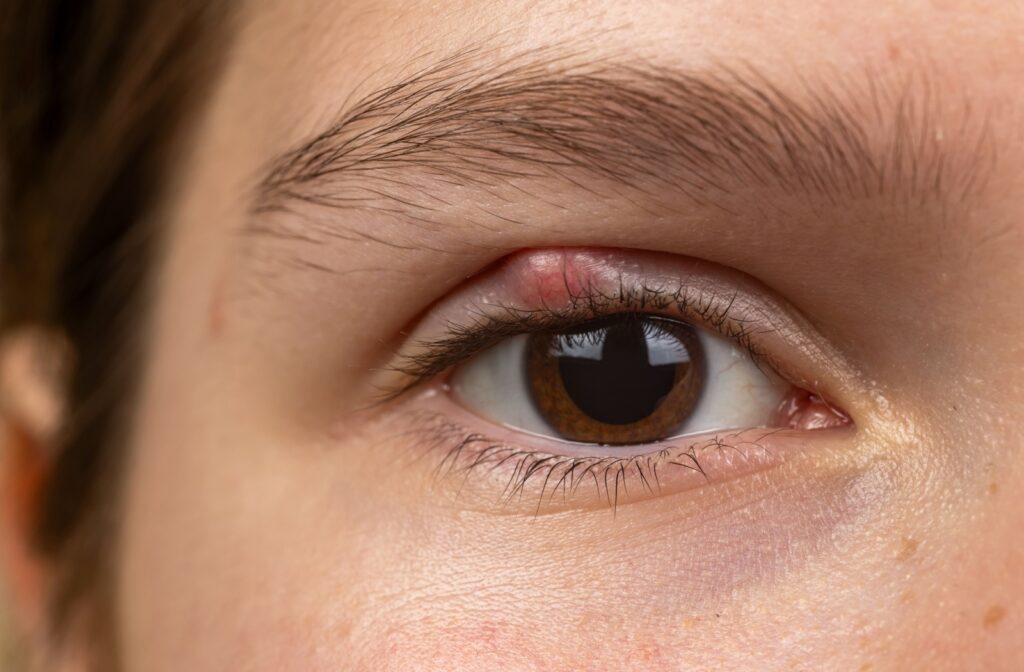Blepharitis is an eye disease that commonly causes red, itchy eyelids. It can lead to uncomfortable, recurring symptoms if left untreated. How long blepharitis lasts depends on the type and how quickly treatment begins, but the good news is most cases respond well to consistent care.
Blepharitis can improve within weeks with proper treatment, though chronic cases may require long-term management to keep symptoms under control.
With the right treatment routine and regular eye care, you can reduce flare-ups, improve comfort, and enjoy clearer, healthier vision.
Acute vs. Chronic Blepharitis
The duration of your blepharitis largely depends on whether you’re dealing with an acute or chronic case.
Acute Blepharitis
Acute blepharitis typically develops suddenly and can resolve relatively quickly with proper treatment. This type often results from bacterial infections or allergic reactions. With appropriate treatment, acute cases usually improve within one to two weeks.
You’ll likely notice symptoms like redness, swelling, and irritation that seem to appear overnight. Their intensity might be concerning, but acute blepharitis tends to respond well to treatment.
Chronic Blepharitis
Chronic blepharitis is more persistent and requires ongoing management. This form often stems from underlying conditions like meibomian gland dysfunction or seborrheic dermatitis. While symptoms may fluctuate, chronic cases can last months or even years without proper care. Don’t let this discourage you. Chronic blepharitis is highly manageable with the right approach.
Timelines: What Treatment Might Look Like
Here are some timelines for what you might expect from treatment for blepharitis:
Week 1-2: Initial Improvement
With proper treatment, most patients notice some improvement within the first week. We might recommend:
- Warm compresses applied 10-15 minutes daily
- Gentle eyelid scrubs with specialized cleansers
- Prescribed antibiotic ointments if bacterial infection is present
- Anti-inflammatory medications to reduce swelling
During this period, you should see reduced redness and less morning crusting around your eyelids.
Week 2-4: Greater Progress
By the second to fourth week, eyelid inflammation should decrease noticeably. Your eyes may feel less gritty, and the burning sensation often associated with blepharitis will typically diminish.
If you’re not seeing improvement by this point, contact your optometrist. You might need a different treatment approach or additional testing to rule out underlying conditions.
Month 1-3: Establishing Control
For chronic cases, the first three months are important for establishing long-term control. This period typically involves fine-tuning your treatment routine and identifying triggers that worsen your symptoms. Many patients find their optimal maintenance routine during this phase, which might include daily lid hygiene and occasional medicated treatments.
Factors That Influence Recovery Time
Several factors affect how quickly your blepharitis resolves:
- Adherence to treatment: Following your optometrist’s recommendations consistently is the most important factor. Skipping treatments or stopping too early can prolong symptoms significantly.
- Underlying conditions: Rosacea, allergies, and autoimmune conditions can extend recovery time. Managing these concurrent issues is essential.
- Personal hygiene habits: Daily eyelid hygiene becomes crucial for preventing flare-ups and maintaining improvement.
- Environmental factors: Dry air, allergens, and screen time can impact your recovery. Creating an eye-friendly environment supports faster healing.
Treatment Options for Blepharitis
Professional Treatments
We may recommend one of several professional treatments:
- In-office procedures: Treatments like meibomian gland expression can provide faster relief for stubborn cases.
- Prescription medications: Topical antibiotics, anti-inflammatory drops, and oral medications may be necessary for severe cases.
- Specialized cleansers: Medical-grade eyelid scrubs are often more effective than over-the-counter alternatives.
At-Home Care
Consistent at-home care can help with recovery:
- Apply warm compresses twice daily using clean washcloths
- Perform gentle eyelid massage to improve oil gland function
- Use preservative-free artificial tears to maintain moisture
- Remove all eye makeup thoroughly before bed
Managing Flare-Ups Effectively
Even with successful treatment, blepharitis can flare up occasionally. Here’s how to help manage setbacks:
- Recognize early signs: Increased redness, burning, or morning discharge often signal the beginning of a flare-up.
- Intensify home care: Double your warm compress routine temporarily and be extra diligent about eyelid hygiene.
- Contact your optometrist: If symptoms persist beyond a few days of intensified home care, schedule an appointment. Early intervention prevents minor flare-ups from becoming major setbacks.
- Identify triggers: Keep a symptom diary to identify what might be causing your flare-ups. Common triggers include stress, hormonal changes, certain cosmetics, and environmental allergens.
Long-Term Outlook & Prevention
With proper management, the long-term outlook for blepharitis is often both positive and manageable. While chronic cases require ongoing attention, most patients can achieve promising symptom control and maintain comfortable vision. Here are some prevention strategies:
- Consistent eyelid hygiene
- Manage underlying health concerns
- Use quality eye makeup and makeup removers
- Replacing eye makeup regularly
- Washing hands before coming in contact with your eyes
Regular follow-up appointments with your optometrist is equally important in helping achieve effective treatment.
Take Control of Your Eye Health Today
Blepharitis is manageable with the right care. Consistent treatment and proper eyelid hygiene can lead to lasting relief and healthier, more comfortable eyes. Book your comprehensive eye exam at 2020 Eyecare Ohio today to get a personalized treatment plan and take the first step toward clearer, more comfortable vision.



